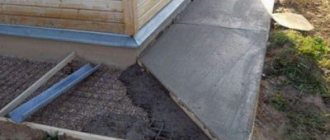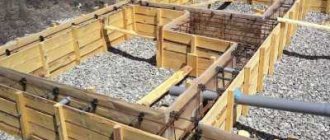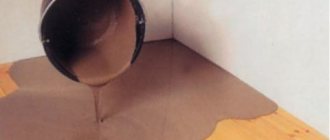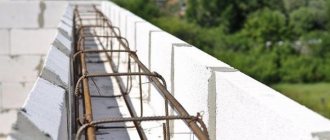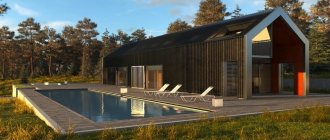Build your own pool and enjoy it all summer long - these are the thoughts that are driving you now. In addition, your kids will also be crazy about the joy that a small pond with cool water will give them on a hot day. And today we will look at how to build a concrete pool with your own hands, what are its advantages and disadvantages and for whom it would be an ideal option.
Requirements for a swimming pool site
To choose the right location, think in advance about how the pump and lighting equipment will be connected, and where the drain will be located. The requirements that we list must be observed, including for frame pools.
- The place should be level, without changes in height, slopes, or potholes. This is necessary for uniform distribution of water and durability of the structure. The maximum deviation is 2-5 mm per square meter.
- Small stones, driftwood below, construction waste, and remnants of the root system (it quickly grows again) are not allowed.
- The soil at the site where the structure is installed must be compacted tightly. Preferably with gravel.
- It is better to place the platform or pit at a sufficient distance from the house and other buildings so that in the event of damage to the system, the foundation will not be flooded.
- Do not place the base for the bowl next to trees or bushes. The water will become polluted faster.
- The place under the destroyed building is not suitable for the podium. There may be cavities left in it, which will contribute to rapid destruction.
- Also, do not use foundations intended for other objects. It has different characteristics and this will affect the stability of the tank.
- The soil should not be loose or creeping; river cliffs and places near a railway or highway are not suitable.
Let's summarize. When choosing a site, it is important that it is level, cleared of all kinds of debris and plants. It is advisable that the soil be compacted, outbuildings and residential buildings, wires, trees, and roads should be far away. It is better to build it in a sunny or half-shaded place that does not block the passage for people.
Instagram @ideiipodelkidliadachi
Instagram @dnevnikmaikla
Along the perimeter, the platform should be larger than the tank itself. So that the water that splashes out of it does not form a puddle. We'll tell you what you can use to make a platform or podium for a swimming pool at your dacha with your own hands.
- Baths, saunas, swimming pools
How to make a swimming pool at your dacha: 3 types of structures and methods of installing them
Order and installation cost
order the installation of a concrete platform for a frame pool:
- in construction companies;
- on sites offering concrete work;
- find craftsmen through friends.
The cost of professional services depends on:
- quality, composition and grade of concrete;
- area and volume of the site;
- the load to which the base will be subjected;
- filling method;
- time of year (work costs more in winter);
- deadlines.
Average cost of pouring a concrete platform with finished formwork:
- manual method - 1500-1700 rubles per cubic meter;
- feed from an auto mixer - 600-100 rubles per cubic meter.
If you order formwork from builders, the price of the work will increase by approximately 800-1000 rubles per cubic meter.
You will find a lot of useful information on making platforms from various materials for a frame pool in this section.
Base materials
The tank can be installed on ground covered with film or sand drainage (SGD). But such a foundation will not be reliable. It would be better to strengthen it. Here's how you can do it.
- Concrete or sand-cement mixture. Durable, moisture-resistant screed does not dry out over time. It is easy to obtain a smooth surface of any shape. Suitable for both removable and stationary pit pools. An excellent option for large areas.
- Boards. Easier to handle material. It’s also easy to get a flat area, but without maintenance, boards can dry out, swell, and rot.
- Decking (terrace board, garden parquet). Wood-polymer modules that do not require special processing. Decking is not afraid of rain and snow - it will not dry out or rot. Laying garden parquet can be difficult; it can fade in the sun or float in the heat.
The photo shows options for different platforms.
Instagram @khayakdolf
Instagram @gvk2008
Instagram @vintovayasvaya
So, the place and materials have been chosen. Now you need to prepare the area.
- Baths, saunas, swimming pools
5 Stunning Pool Sites You'll Love
Advantages of frame structures - why choose them?
Seasonal pools based on a reliable frame are ready-made factory containers made of durable plastic and reinforcing metal elements. The inside of such structures is covered with a special film. It has high strength indicators. And its surface, due to treatment with special compounds, acts as a water disinfectant. Factory-produced frame tanks have the following advantages:
- quick and trouble-free assembly (easy to do with your own hands);
- affordable price;
- ease of water replacement (usually used liquid is drained through a hose into the garden);
- easy operation;
- easy cleaning of the bottom of the structure using a hand-held vacuum cleaner and an ordinary pump;
- their kit often includes pleasant additions - pool skimmers, professional chemical kits, and so on.
Preparing the site
Territory marking
There are several marking methods. In any of the proposed options, add 0.15 meters or more to the size of the structure if you plan to build a wide platform.
- Rectangular, square. Stick four sticks into the ground and stretch a rope between them so that the corners are right.
- Round. Where the middle of the tank is supposed to be, dig a post into the ground and tie a long rope to it. Tie paint in a can to its second end, and then draw a circle. Instead of paint, you can take a bottle of sand and mark the boundaries with it. Or tie a sharp stick to the free end of the rope and draw a circle on the ground. Another option is to pierce the ground, and install other pegs in place of the punctures, stretching a rope between them.
- Elliptical. Draw three or two circles and then connect them by eye using one of the methods listed above.
Instagram @fauxfarmhouseranch
Instagram @family_build
- Landscape
6 useful and beautiful ideas for decorating a swimming pool on your property (you’ll want to repeat them)
Clearing the area
If you are preparing a ground area, use a bayonet shovel inside the marking to remove the turf. Stick the shovel completely into the ground - 30-40 cm. However, experts do not recommend making a hole more than half a meter. It is recommended to fill deeper holes with concrete and lay brickwork around the perimeter.
The removed turf can be used to create lawns on the site. Remove remaining roots, herbs, and stones from the cleared area. Then treat it with drugs that slow down plant growth.
For a stationary pit pool, dig a hole to a depth of 2.5 meters - if you plan to jump into the water from the side and 1.5-2 meters - for structures with steps. Use a level so that the bottom of the pit has a slope of 4 cm by 1 meter towards the drain.
Large frame tanks are always made in a small recess. This way they will be more stable, and less water will accumulate around them. This installation option is also suitable for loose soils.
Instagram @catdigger177
Instagram @fauxfarmhouseranch
Leveling and compaction
Make a 20-25 cm sand cushion at the bottom of the pit or on top of the ground. It will become an excellent shock absorber if there is a busy road nearby. Level and compact it with the help of construction beacons, a level, and rules. Tamping can also be done with a vibrating plate or ordinary water. Water the future platform several times with water from a hose and sprayer, and then level it. Sand can be replaced with ASG and cement. The ratio of components in this mixture is 10:1.
For a small tank, such a pillow is often enough. Geotextiles or thick film are laid on it, and a bowl is placed on top. If it is more than 1-2 cubes, the prepared area is strengthened using one of the methods described below.
Instagram @rspools
Instagram @liudmilachurukevich
Problems and difficulties during creation
When building a concrete foundation yourself, it is important to pay attention to the following points and tips:
Keep in mind that concrete tends to strongly compress and expand with temperature changes.
This problem is solved this way: the solution must be poured 2 cm below the top line of the formwork.- The mixture must be poured at once or in parts.
The second option is undesirable, as it can lead to defects. If there is no assistant nearby, you will have to break the site into parts - sectors, and carefully fill them one by one. - The problem of uneven drying of concrete can be solved by pouring a small amount of water on the surface.
- If after pouring the mixture it rains immediately, the solution will wash away.
- If the site is being built during the cold season, after pouring it should be covered with film until the concrete hardens to protect it from frost and precipitation.
- The base should not be installed adjacent to other structures. Since concrete can expand, neighboring buildings may be damaged.
- When arranging a large site, deformation gaps are necessary to prevent expansion and contraction of the concrete pour.
- While the mixture is drying, do not touch it with your hands, step on it, or drop anything on the surface, so as not to leave marks.
Do-it-yourself concrete platform for a swimming pool at the dacha
Making a foundation pit
For work, frost- and water-resistant concrete of grade M100 or M300 is used. If you prepare the mixture yourself, take coarse sand, crushed stone, cement and additives to increase water resistance. The latter are sold ready-made. Conduct all communications in advance.
- Lay two layers of roofing material overlapping on a sand or sand-gravel cushion.
- Seal the joints with mastic or sealant.
- Lay another sheet of roofing material on top.
- Cover the joints again with mastic or sealant.
- Lay the reinforcement on the bricks so that you get a grid with 20x20 cm cells. Bend the ends of the rods onto the walls.
- Start pouring the mixture. The recommended layer thickness above the mesh is five centimeters.
- Level the mixture and pierce it in several places with a sharp stick so that there are no air bubbles left inside.
- Cover the bottom with film or spray it every day to prevent the concrete from cracking as it dries.
- When the bottom hardens, install the formwork on the walls. You can build it from plywood.
- Make a reinforcing mesh at a distance of 5 cm from the formwork. Tie the new rods to the ones that are bent at the bottom.
- Secure the mesh with diagonal slats.
- Pour the concrete.
- When it dries, plaster the surface.
Check if the waterproofing is done well. Fill with water, mark its level and leave for two weeks. Taking into account natural evaporation, no more than 2 cm should go away. If all is well, you can begin finishing. This is also additional waterproofing. Instead of roofing felt, you can use geotextile fabric, thick film, or polypropylene.
Instagram @ekskavatorpogruzchikizhevsk
Instagram @oazis_ul
Instagram @oazis_ul
Making a podium
For work it is recommended to use concrete M100 or M300. Hydrophobic additives, cement, crushed stone and coarse sand are added to the mixture, made independently.
- Lay overlapping sheets of geotextile, film or roofing felt on a sand or sand-gravel bed.
- Seal the joints with mastic or sealant.
- Place reinforcing mesh on the bricks with a cell size of 20*20 cm.
- Make the formwork the desired height.
- Pour concrete or cement-sand mixture (1:3) and level it.
- Pierce it in several places with a sharp stick so that there are no air bubbles left inside.
- When the mixture sets, remove the formwork and wait until it dries completely.
- Cover the surface with plaster, primer and, if desired, waterproof paint and tiles.
Instagram @konakovokolodec
Instagram @svetlanaelshankina
Instagram @_natashik_1804
Creating a recess
Large frame structures are placed in such pits halfway or slightly lower. They become more stable, more aesthetically pleasing and you don’t need a ladder to climb inside. The approximate depth of the hole is one and a half meters. When calculating the width of the pit, take into account the need to erect retaining walls.
- Pour a layer of 20-30 cm of ASG onto the bottom and compact it.
- Make a thin screed from a cement-sand mixture. It will separate the main slab from the ASG.
- When it dries, place a reinforcing mesh on top with cells no larger than 25*25 cm.
- Fill with M100 or M300 concrete. The recommended slab thickness is 10-15cm.
- Cover the slab with film while drying.
- Once the surface has hardened, build retaining walls for the frame. They are made from bricks or cinder blocks.
- Plaster the walls.
Instagram @maxim_jcb8030
Instagram @sp.petuhov
The video shows another way to strengthen the frame structure.
- Deepening and leveling the site.
- Installation of the frame.
- Strengthening the walls with blocks.
- Adding gravel.
If you decide to bury a small tank, you can do without a screed. In this case, they make the same pillow from ASG, and support posts for the frame are dug in around the perimeter to a depth of 50-60 cm. Crushed stone is poured into the holes with them, and the racks themselves are covered with liquid waterproofing or bitumen. A shalevka is nailed to them horizontally.
Instagram @zemelnye_raboty_zp_ukraine
Instagram @sp.petuhov
Pros and cons of concrete for site construction
Advantages of a concrete pool platform:
high strength and reliability;- durability of service provided that high-quality materials are used and manufacturing technology is followed;
- resistance to high humidity and temperature changes;
- wear resistance;
- grass does not grow on the concrete surface;
- easy to clean - sweep and wash;
- environmental Safety;
- ease of work and the possibility of self-installation;
- affordable cost, no need to use expensive tools.
Flaws:
- concrete becomes dusty if it is not covered with finishing materials;
- risk of coating deformation in severe frosts;
- hardening and hardening of concrete will require at least 20 days;
- not very aesthetically pleasing;
- If cracks appear, it cannot be repaired; the layer will have to be completely replaced.
steps
The next step in building a wooden deck is to install the frame for the steps. The basis is the stringers, which are located at a distance of 16 inches from each other.
Scheme of stringers
To make them, use a board with a cross section of 2x10. In order for all the steps to be the same in length and height, you first need to make a pattern for one step, and then sequentially mark the steps on the blank for the stringer.
Stair stringer is a sawtooth-shaped wooden board or beam with rectangular teeth
There are, of course, non-standard sizes of steps, but most often they are made within the limits given above.
At the bottom, all stringers are connected by one board for stability of the structure. Figure 7 shows the frame of the terrace and steps.
Figure 7. Frame of the terrace and future steps
Introduction
Arranging a sauna pool is not the easiest task.
This is a labor-intensive task that requires not only physical but also financial investments. But all the difficulties that the master has to face will be completely justified, because a cool pool in which you can swim after a steam room is simply indescribable bliss. The peculiarity of the pool in the bathhouse is that short-term and sudden changes in temperature are very useful for the human body. This can significantly strengthen your immune system and improve your mood. But not everyone can afford a full-fledged swimming pool. This requires a sufficient amount of free space, so it is best if such an addition is planned during the construction phase. This can significantly save time and money. There are a huge number of bathhouse projects with swimming pools for every taste and budget. But they all have one important feature, namely high requirements for waterproofing and fire safety
Therefore, even at the planning stage, it is always recommended to pay special attention to the material from which the bathhouse will be built. Recently, experts are increasingly recommending laminated veneer lumber, as it has a huge number of advantages compared to other options.
Supports
Consider the option of arranging concrete supports with a diameter of 12 inches each.
| Feet | Centimeters | Inches | Centimeters |
| 1 | 30,48 | 1 | 2,54 |
| 2 | 60,96 | 2 | 5,08 |
| 3 | 60,96 | 3 | 7,62 |
| 3,5 | 106,68 | 3,5 | 8,89 |
| 4 | 121,92 | 4 | 10,16 |
| 5 | 152,4 | 5 | 12,7 |
| 10 | 304,8 | 12,7 | 32,258 |
| 11 | 335,28 | 11 | 27,94 |
| 12 | 365,76 | 12 | 30,48 |
| 15 | 457,2 | 15 | 38,1 |
| 20 | 609,6 | 20 | 50,8 |
- According to the project, holes are dug of the appropriate diameter and a depth of about 4 feet.
- Afterwards, so-called “sleeves” made of roofing material secured with adhesive tape are inserted into these holes. They should protrude approximately 1 foot above the ground surface.
- Concrete is poured into these “sleeves”, and metal connectors are installed on top, to which wooden supports will be attached.
To avoid digging holes again, make a sketch with dimensions that will show the coordinates of each support. It’s better, of course, to do this on a site plan, especially if there are plants in the construction area or there are communications, then you won’t have to uproot a tree or repair the water supply.
Figure 2 shows the location of concrete supports (Footings), as well as their coordinates. If the support ends up on a water pipe, or if there is a tree growing nearby, simply move the support slightly to the side. It is better to calculate everything and draw it on paper rather than face unpleasant surprises during the construction process.
Figure 2. Location of supports
Having marked the location of the supports on the site, dig holes for them and concrete them. Don't forget to install post connectors into the wet concrete supports. After the concrete has hardened, secure the vertical supports in metal connectors. Use 4" x 4" cross-section posts for supports since the deck is less than 6 feet high.
Figure 3. Scheme of concrete supports
Beginning of work
First you need to dig a pit. To do this, if you want a large pool, you will need special equipment, and the dimensions will need to be adjusted to pinpoint accuracy with a shovel. If your goal is a small bowl and to lose a couple of sizes, you can start digging a pit yourself, by hand. Keep in mind: the bottom should not be lumpy, and the walls should be perfectly smooth, but have a small angle (5 degrees is enough so that the earth does not fall off).
You need to understand: when you transfer the outline of the pool to the construction site, they need to be increased: on each side, as a rule, 60-80 centimeters are added. And add about 50 cm more to the desired depth - for the bottom plate and the thickness of the finishing material.
When the pit is ready, you need to lay a drain pipe: dig a pit, a trench for it and install it (and bring the drain pipe up).
And then the installation of the “pillow” begins. A layer of sand and gravel is poured successively over the laid drain pipe, then compacted. Next is roll waterproofing in two layers (you shouldn’t skimp on it either). And all this must be done with a slope towards the drain pipe. Waterproofing can be “doubled” - laid not only on top of the “pillow”, but also on the ground.
Photo: remstroiblog.ru
Limitations that cannot be ignored
It is worth understanding that in some cases construction is not practical. For example, you cannot begin work on the construction of a foundation on slopes, hills, loose moving soils, wooden platforms, or near roadways or railroad tracks.
Unfinished foundations, once built on the site for other buildings - gazebos, bathhouses, sheds - are also a bad option for construction. They may not be able to cope with the load and lead to the collapse of the bowl in the future.
What can be put under the frame for different forms of relief?
The condition of the site depends on the materials used in its manufacture. Using a substrate you can compensate for some surface imperfections.
Flat land
What to lay under a beautiful swimming pool? On a flat area, a regular underlay , which can be bought in a retail chain, is sufficient.
It consists of several layers of polyethylene foam, sometimes with an additional reflective layer.
If the surface of the platform is insulated, you can use any film (polyethylene or polypropylene, PVC) to separate the insulation from the material of the bottom of the bowl.
Uneven
If the terrain of the site is uneven, the site will have to be made multilayer . You will need to lay a sand cushion, which is carefully compacted.
Sometimes, on moving and unstable soils, a podium is made around the bowl. An air gap remains between the ground surface and the supporting structure, allowing contact with an unstable surface to be cut off.
Where and at what price can I order turnkey production?
Manufacturing should be ordered from construction organizations .
It is recommended to contact officially registered companies that guarantee their work. It is advisable to order the production of a platform if the size of the pool is large and the use of construction equipment and devices is required to complete all work. For example, sand compaction performed using a vibrating plate can only be performed efficiently by professionals.
The cost of work depends on the size and design of the base . On average, the cost can be calculated by the number of materials required - usually it is multiplied by 2 and the full amount is received for the construction of the site.
For example, if sand and other materials are required for 5 thousand rubles, then the estimated cost of the entire order will be somewhere in the region of 10 thousand. However, other options are possible if you have to carry out a large volume of excavation work with soil removal.
What can a platform be built from?
At first glance, it is easiest to build a podium from brick and concrete; in practice, such a design turns out to be too complex and requires a solid foundation and backfilling of the soil cushion.
Important! If the steps of the ladder can somehow be built next to the bowl of the reservoir at minimal cost, then it is impossible to assemble a path parallel to the upper edge of the pool without special brick racks and a reliable foundation. The result will be a monumental structure that will be more of a nuisance at the dacha than a delight with its presence.
It is best to make a frame from a wooden beam
A small swimming pond is usually assembled during the summer season, after which the pool is disassembled and transferred to storage. The wooden parts of the podium can be made stationary or also collapsible.
You can make a pool deck on racks made of pipes, metal or asbestos-cement. Such a structure will be much more practical than a concrete one, but it will still be quite difficult to make it collapsible. In addition, under such racks it will be necessary to pour pillows and form installation sleeves. All this is quite expensive and not very practical.
Pipe base will support any size deck
The easiest way to build a frame pool podium is from wood. Any lumber available at the dacha will be used - scraps of timber, remnants of slatted cladding, lining and even pallets. The latter are considered to be the most promising material; making a podium from pallets will not be difficult, even without disassembling them into planks.
Alternative
Other types of heat insulators are recommended that can perform the same functions:
- Styrofoam. It crumbles and requires laying a hard sheet layer (plywood or chipboard) on top, but otherwise the material can serve as a base for a pool.
- Izolon. This is foamed polyethylene. Rigid varieties with high density differ little in their qualities from penoplex.
- Technoplex, Stirex, Extrol are types of polymer boards whose parameters are similar to penoplex.
- Arbolit. A mixture of wood chips and cement mortar. It has high strength, but is not resistant to water.
- Foam glass. This material retains heat well and is highly durable. However, it is expensive and rarely found on sale.
All materials have their own specific characteristics, so you need to choose carefully, taking into account all the features and factors.



